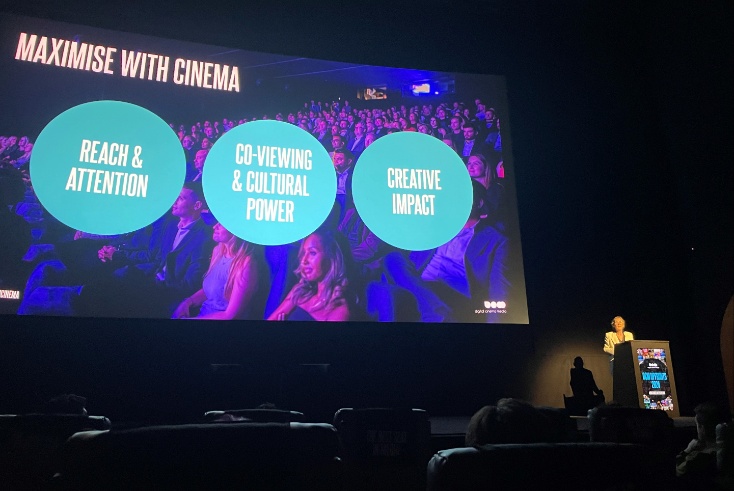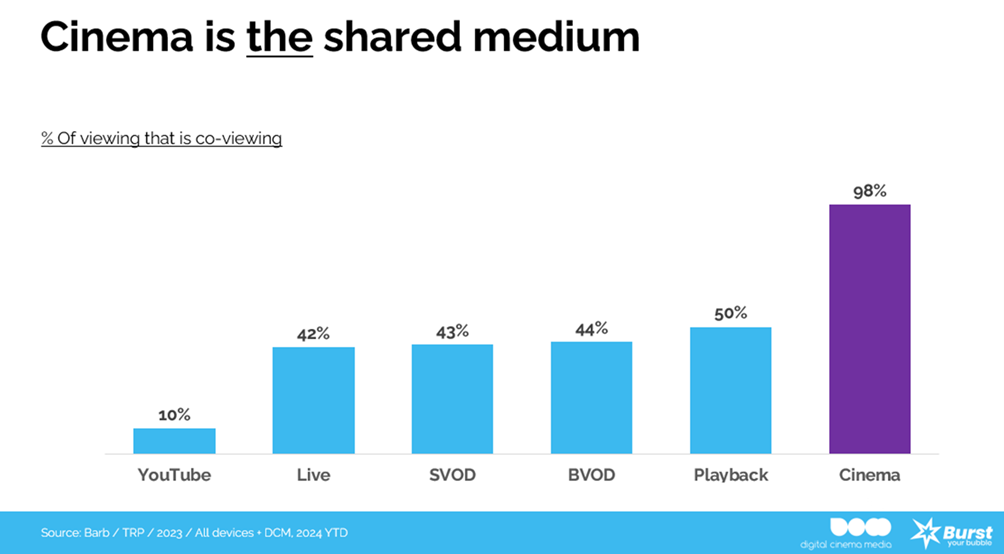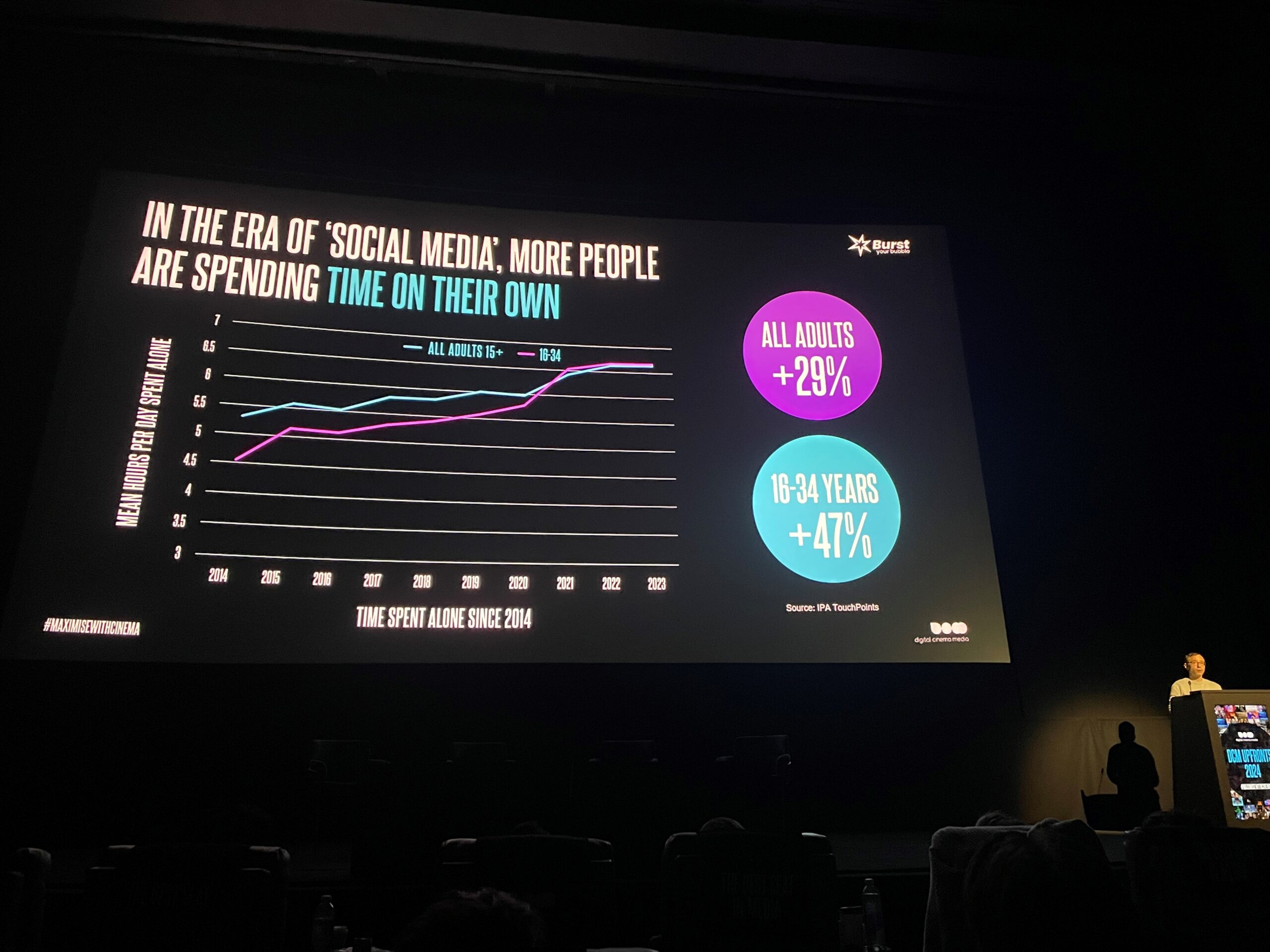Why brands should embrace cinema as the ‘original social media’

Cinema should be seen as “the maximiser medium” on campaigns for commercial, cultural and social impact in a world focused on targeting and retargeting, while its shared experience is an antidote to increased isolation, particularly among young people.
These were some of the takeaways at the upfronts of Digital Cinema Media (DCM), which showcased new research about the importance of overwhelmingly shared viewing in cinemas and innovations in advertising in the medium.
Karen Stacey, DCM’s CEO, told delegates: “I think what we show today is that sometimes in life, when people are zigging, you need to zag. Everyone is talking about targeting, retargeting, how they can reach their audience and we know that that’s fine and that is the domain of many. However, in cinema, we believe we’re not going to do that.
“We’re about maximising the impact we have on your schedule and maximising the commercial impact we have with your advertisers. We’re about attention. We’re about co-viewing and we’re about being a part of culture — and we’re unashamedly believers in ‘one to many’.”
Need for togetherness
Andrew Tenzer, co-founder at research agency Burst Your Bubble, illustrated this argument using a study conducted with DCM that found sharing the cinema experience with a wider audience helped social, cultural and commercial impact.
In The Cultural Power of Cinema, DCM found, using point-of-sale data, that 98% of all cinema showings are a shared viewing experience — more than TV and YouTube figures from Barb and Thinkbox.

This is amid a wider sense in society that there is “a lack of togetherness” and “a feeling of isolation from others”, particularly among young adults.
Tenzer cited figures from IPA TouchPoints that, since 2014, time spent alone was up 47% for 16- to 34-year-olds, outpacing the 29% increase for all adults. This spiked during the height of Covid-19 and has not returned to pre-pandemic levels. And all this is taking place in “the so-called era of social media and connectedness”, Tenzer pointed out.

The DCM and Burst Your Bubble research found more than half of adults (55%) agreed with the statement “there is no sense of community any more” and 60% of young people said they “feel distant from other people”.
Tenzer said: “This should lead us to the conclusion that the ‘whole world at your fingertips’ digital narrative is a hollow one.” Indeed, he added: “Social media just isn’t that social.”
The study showed “a strong need for social assurance” and that people universally still “crave” moments of togetherness like gigs, live sports and cinema, with seven in 10 people agreeing that “events that bring people together are more important now than ever”.
There are fewer shared experiences and that has led AV plans to “increasingly tip the balance” away from “tapping into the full power of a shared view” and “collected cultural resonance”, Tenzer argued.
Cinema, in this context, is “more than just a media channel” and its USP is that it is always a shared and collective experience, unlike other channels. He continued: “”Cinema is unique because it delivers strong community outcomes, so it is recognised as being a concrete and universal thing in the community. It’s not virtual, it’s there for real and it’s an institution in the community, just like pubs and social clubs — all of the things that are slowly fading away from society.”
Using social psychology frameworks, the study found that cinema reduced the individualistic view of other people and drove a feeling of closeness to others. As Tenzer put it: “Our research shows that you don’t need to be a regular cinema-goer to understand its significance and the positive role that it plays in the community and for social cohesion.”
Benefit of shared experience
Audiences see the ads and trailers as part of the experience and they generate moments of talkability for brands, with 67% of 16-34s agreeing that they “enjoy talking about the ads with other people” at the cinema.
Analysing five cinema campaigns that ran in May and June, DCM and Burst Your Bubble found exposure to cinema ads resulted in “significant uplifts” across social impact, brand fame and signalling.
The five brands saw a 50% uplift in “community” association, alongside a 106% increase in association with “universalism”. At the same time, the campaigns saw a 12% rise in those agreeing with the statement “everyone knows this brand” and 26% growth in “everyone likes this brands”.
When it comes to positive signals, 37% more agreed with the statement “if I use this brand, most people think I’ve made a good choice”, while 21% more associated the brands with “high-quality products and services”.
These findings were echoed by Alex Taborda, head of media development and execution, professional products division, at L’Oréal. He cited the example of the Prada Paradoxe perfume launch cinema ad with Emma Watson that found uplift in both brand awareness and in consumers’ association with premium and prestige.
Strong angle
Tenzer summarised three takeaways for media planners and buyers. First, cinema is “the original and authentic social media” that has “powerful community effects” and is “tangible”. Secondly, cinema is “a very, very, very high-quality environment for brands to be in”. Finally, achieving cultural impact and social impact are “not a false dichotomy” and cinema is where you can achieve both.
Speaking to The Media Leader about the research, Jonathan Chambers, director at Generation Media, said describing cinema as the original social media was “a powerful message” to try to land with agencies and brands.
In addition, the growing social isolation and the power of connection was “a strong angle” that “should resonate with what brands are looking to achieve”.
He added: “I’d be interested to hear brand reactions to this, though, and whether it can convince more to include cinema in the mix considering the ease at which paid social and other digital platforms are included.”
Chambers said he was also interested in the reaction of social media platforms to the study’s claims that they are “potentially driving isolation”, especially in a week when they will play “a huge part” in a vote that has been dubbed “the TikTok election”.
Upcoming innovations
DCM content business director Tom Linay and DCM Studios creative director Jeremy Kolesar also took the opportunity to explore innovations in cinema advertising.
Kolesar revealed that, in a media first, anamorphic 3D would be coming to DCM screens this year after working with 3Rock Global. Meanwhile, DCM has been using generative AI to assist with immersive cinema advertising on Screen X viewings, where screens span three walls for a 270-degree experience.
Linay and Kolesar also unveiled a new “Dead Cool Films” package for brands to align themselves around horror and thriller movies with gold spots and idents. Horror is a genre brands have “often shied away from” when it is “such an attractive audience for a brand”, Kolesar emphasised.
DCM found that horror was the most-shared film genre, with its audiences twice as likely to be “heavy cinema-goers”, 53% of whom are likely to go in groups of more than four and it is also the best-loved genre among 16- 34s.




